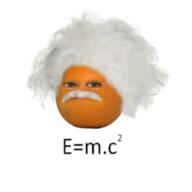✔ 最佳答案
圖片參考:
http://imgcld.yimg.com/8/n/HA04717316/o/701101010021413873434880.jpg
The "arrow" sign means the direction of dipole moment.
F is more electronegative than B and thus exert a force to withdraw electrons
圖片參考:
http://imgcld.yimg.com/8/n/HA04717316/o/701101010021413873434891.jpg
圖片參考:
http://imgcld.yimg.com/8/n/HA04717316/o/701101010021413873434892.jpg
F1 = F2sin30o + F3sin30oF1 = F2(1/2) + F3(1/2) F2cos30o = F3cos30o
∵ F1 = F2 = F3∴ ↑F = ↓F , ←F = →F
2011-01-01 14:09:17 補充:
non-polar: (1) electronegativity difference between atoms is zero or
(2) the vector sum of dipole moment in the molecule is zero
e.g. CH4
2011-01-01 14:11:56 補充:
But, I prefer you to remember the second feature because the first statement is incorrect.
For example, ozone(O3) electronegativity difference between atoms is zero, however, the vector sum of dipole moment in the ozone molecule is not zero and thus O3 is a polar molecule


